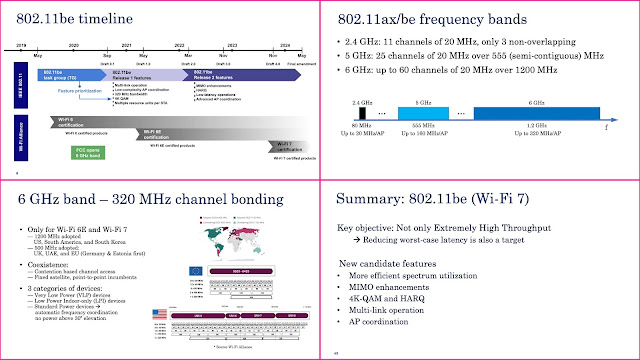We have looked at Wi-Fi 7, a.k.a. IEEE 802.11be earlier. The technology is still undergoing standardization with a final release expected in 2024. A recent IEEE Spectrum article details speed evolution of IEEE 802.11.
Wi-Fi went mainstream with the 802.11g standard in 2003, which improved performance and reliability over earlier 802.11a/b standards. My first 802.11g adapter was a revelation when I installed it in my ThinkPad’s PC Card slot. A nearby café jumped on the trend, making a midday coffee-and-classwork break possible. That wasn’t a thing before 802.11g.
Still, 802.11g often tried your patience. Anything but an ideal connection left me staring at half-loaded Web pages. I soon learned which spots in the café had the best connection.
Wi-Fi 6, released in 2019, has maximum speeds of 600 megabits per second for the single band and 9,608 Mb/s on a single network. That’s nearly 40 percent as fast as the Wi-Fi 5 standard and more than 175 times as fast as the 802.11g connection I used in 2003.
Those figures, while impressive, don’t tell the whole story. Peak Wi-Fi speeds require support on each device for multiple “spatial streams”—that is, for multiplexed channels. Modern Wi-Fi can support up to eight spatial streams, but most consumer-grade Wi-Fi adapters support just one or two streams, to keep costs down. Fortunately, Wi-Fi 6 boosts the performance per stream enough to lift even entry-level Wi-Fi adapters above gigabit speeds.
Wi-Fi 6E, released in 2020, further improves the standard with a 6-gigahertz band that appears as a separate connection, just as 2.4- and 5-GHz bands have appeared separately on prior Wi-Fi networks. It’s early days for Wi-Fi 6E, so device support is limited, but the routers I’ve tested were extremely consistent in hitting the peak potential of gigabit Internet.
Wi-Fi 6 already reaches a level of performance that exceeds the Internet service available to most people. Yet the standard isn’t letting off the gas. MediaTek plans the first demonstration of Wi-Fi 7 at CES 2022 (the standard is expected to be released in 2024). Wi-Fi 7 is expected to boost maximum bandwidth up to 40 gigabits per second, four times as fast as Wi-Fi 6. Such extreme bandwidth is obviously overkill for Web browsing, but it’s a necessity for streaming augmented- and virtual-reality content.
In a recent NTT Technical Review article, NTT said that they have been researching and developing high-efficiency Wi-Fi technologies to optimize the network within a venue and provide stable throughput with an eye to creating new viewing styles and new types of events. For example, these technologies will enable the flexible allocation of communication resources in accordance with network demand per unit area and the provision of flexible networks that can improve throughput at particular locations such as premium seating and press galleries. These wireless technologies have been given the group name Cradio® [4], which they plan to continue to research and develop towards their implementation of the Innovative Optical and Wireless Network (IOWN) vision.
The wireless resource control technology derives an optimal combination of Wi-Fi parameters such as the operating frequency channel, bandwidth, and transmission power of each AP depending on the radio-interference conditions among multiple APs (Fig. 1). It derives, in particular, an optimal channel combination that avoids interference between APs through iterative optimization processing using a genetic algorithm. Carrying out this processing dynamically enables the parameters of each AP to be controlled in accordance with changes in the environment.
Giovanni Geraci from Univ. Pompeu Fabra in Barcelona, Spain has a fantastic tutorial explaining Wi-Fi 7 in less than an hour. It is embedded below:
We are sure to be revisiting this topic as and when more interesting details are available.
Related Posts:
- The 3G4G Blog: Wi-Fi gets new name
- The 3G4G Blog: Wi-Fi 6 (a.k.a. 802.11ax) and other Wi-Fi enhancements
- Connectivity Technology Blog: Next-generation Wireless LANs in the IEEE 802.11 Working Group
- Connectivity Technology Blog: IEEE 802.11be Extremely High Throughput (EHT), a.k.a. Wi-Fi 7
- Connectivity Technology Blog: 5G vs Wi-Fi Debate for Indoor Connectivity
- Operator Watch Blog: South Korea's Ministry promotes Wi-Fi 6, says WiFi is like 5G
- Connectivity Technology Blog: Is Li-Fi Gaining Momentum as an Alternative Beyond 5G?
- The 3G4G Blog: 5G and Fixed-Mobile Convergence (FMC)
- Connectivity Technology Blog: Road to 6 GHz in Europe - ideal for Wi-Fi and 5G in unlicensed bands
- Free 6G Training: NTT's Road to Innovative Optical and Wireless Network (IOWN)
- The 3G4G Blog: 5G eXtended Reality (5G-XR) in 5G System (5GS)


Comments
Post a Comment